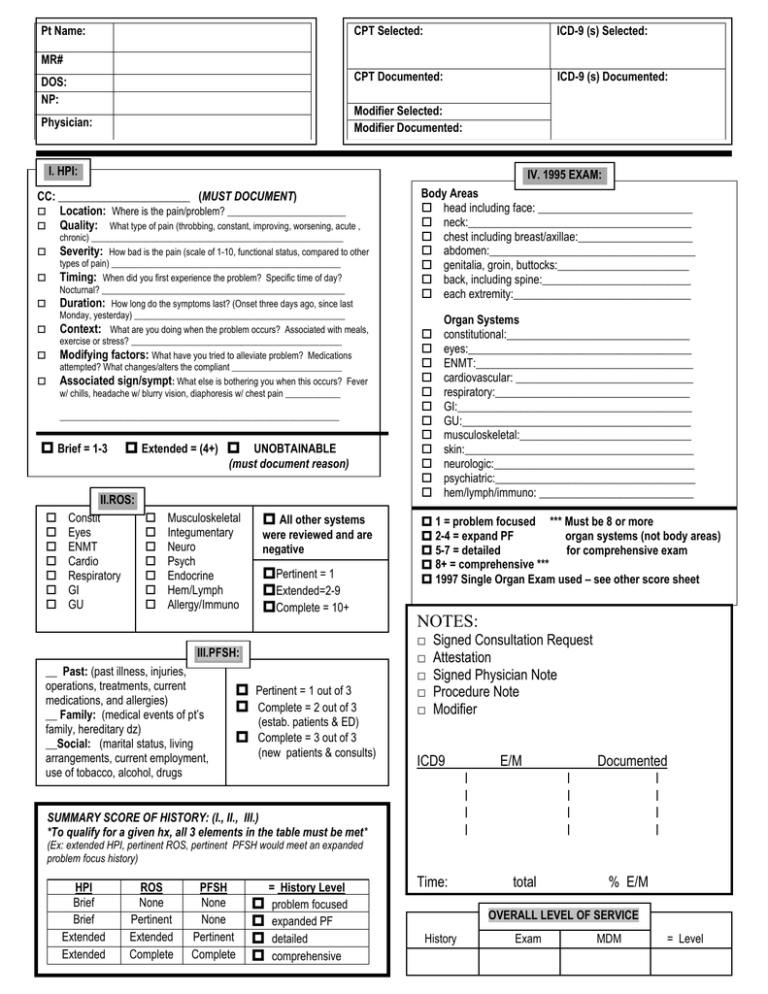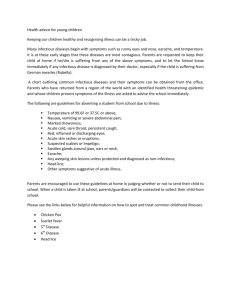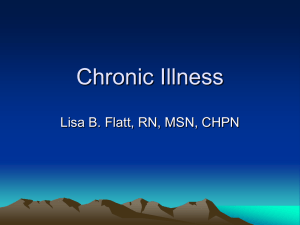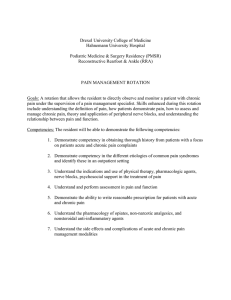Pt Name: CPT Selected: ICD-9 (s) Selected:
advertisement

Pt Name: MR# DOS: NP: CPT Selected: ICD-9 (s) Selected: CPT Documented: ICD-9 (s) Documented: Modifier Selected: Modifier Documented: Physician: I. HPI: IV. 1995 EXAM: CC: _______________________ (MUST DOCUMENT) Location: Where is the pain/problem? _______________________ Quality: What type of pain (throbbing, constant, improving, worsening, acute , chronic) _______________________________________________________ How bad is the pain (scale of 1-10, functional status, compared to other types of pain) __________________________________________________ Timing: When did you first experience the problem? Specific time of day? Nocturnal? _____________________________________________________ Duration: How long do the symptoms last? (Onset three days ago, since last Monday, yesterday) ______________________________________________ Context: What are you doing when the problem occurs? Associated with meals, exercise or stress? ______________________________________________ Modifying factors: What have you tried to alleviate problem? Medications attempted? What changes/alters the compliant ________________________ Associated sign/sympt: What else is bothering you when this occurs? Fever w/ chills, headache w/ blurry vision, diaphoresis w/ chest pain ____________ Severity: _____________________________________________________________ Brief = 1-3 Extended = (4+) UNOBTAINABLE (must document reason) II.ROS: Constit Eyes ENMT Cardio Respiratory GI GU Musculoskeletal Integumentary Neuro Psych Endocrine Hem/Lymph Allergy/Immuno All other systems were reviewed and are negative Pertinent = 1 Extended=2-9 Complete = 10+ III.PFSH: __ Past: (past illness, injuries, operations, treatments, current medications, and allergies) __ Family: (medical events of pt’s family, hereditary dz) __Social: (marital status, living arrangements, current employment, use of tobacco, alcohol, drugs Pertinent = 1 out of 3 Complete = 2 out of 3 (estab. patients & ED) Body Areas head including face: ___________________________ neck:_______________________________________ chest including breast/axillae:____________________ abdomen:____________________________________ genitalia, groin, buttocks:_______________________ back, including spine:__________________________ each extremity:_______________________________ Organ Systems constitutional:________________________________ eyes:_______________________________________ ENMT:______________________________________ cardiovascular: _______________________________ respiratory:__________________________________ GI:_________________________________________ GU:________________________________________ musculoskeletal:______________________________ skin:________________________________________ neurologic:___________________________________ psychiatric:___________________________________ hem/lymph/immuno: ___________________________ 1 = problem focused *** Must be 8 or more 2-4 = expand PF organ systems (not body areas) 5-7 = detailed for comprehensive exam 8+ = comprehensive *** 1997 Single Organ Exam used – see other score sheet NOTES: □ □ □ □ □ Signed Consultation Request Attestation Signed Physician Note Procedure Note Modifier Complete = 3 out of 3 (new patients & consults) ICD9 SUMMARY SCORE OF HISTORY: (I., II., III.) *To qualify for a given hx, all 3 elements in the table must be met* (Ex: extended HPI, pertinent ROS, pertinent PFSH would meet an expanded problem focus history) HPI Brief Brief Extended Extended ROS None Pertinent Extended Complete PFSH None None Pertinent Complete = History Level problem focused expanded PF detailed comprehensive Time: l l l l E/M total l l l l Documented l l l l % E/M OVERALL LEVEL OF SERVICE History Exam MDM = Level Complexity of Medical Decision Making: I. Type and Number of Presenting Problems A x max = 2 B single self-limited or minor problem: stable, improved or worsening established problem (to examiner): stable, improved, resolving/resolved 1 established problem (to examiner): worsening, inadequately controlled 2 new problem (to examiner): no additional work-up planned new problem (to examiner): with additional assessment, consult or diagnostic studies max = 1 = C 1 3 4 Total II. Amount and Complexity of Data Points review and/or order of clinical tests 1 review and/or order of tests in CPT radiology section 1 review and/or order of tests in CPT medicine section 1 discussion of test results with performing physician 1 independent review of image, tracing or specimen 2 decision to obtain old records and/or obtain history from someone other than patient 1 review and summarization of old records &/or obtaining hx from someone other than patient 2 Total Level of Risk III. TABLE OF RISK Diagnostic Procedures Ordered Presenting Problem (s) • One self-limited or minor problem (rash or oral ulcers, cold, insect bites) • • • Two or more self-limited or minor problems or symptoms One stable chronic illness (well-controlled HTN or NIDDM, BPH) Acute uncomplicated illness (e.g., cystitis, allergic rhinitis,simple sprain) • One or more chronic illness w/ mild exacerbation, progression, or side effect of treatment Acute illness with systemic symptoms, eg. pyelonephritis, pneumonitis, colitis Two or more stable chronic illnesses Acute complicated injury (vertebral compression fracture, head injury w/ brief LOC) Undiagnosed new problem with uncertain prognosis, eg. lump in breast One or more chronic illnesses w/ severe exacerbation, progression, or side effects of tx Acute or chronic illness that may pose a threat to life or bodily function ( eg. progressive severe RA, multiple trauma, acute MI, PE, severe respiratory distress, psych illness w/ threat to self or others, acute renal failure) An abrupt change in neurological status, eg. Seizure, TIA, weakness, or sensory loss Minimal Low Moderate • • • • • High • • • • • • • • • • • • • • • • • • • • Lab tests requiring venipuncture Chest x-rays EKG/ECG UA Ultrasound MRI/CT, PFT’s Superficial needle biopsies Clinical lab test requiring arterial puncture Skin biopsies Diagnostic endoscopies with no identified risk factors Cardiovascular imaging studies w/ contrast, no risk factors (arteriogram) Arthrocentesis, LP Physiologic tests under stress test eg,(cardiac stress test) Deep needle or incisional biopsy Cardiac EP tests Cardiovascular imaging studies w/contrast, w/ identified risk factors Diagnostic endoscopies w/ identified risk factors Discography Management Options Selected • • • Rest Splints Superficial dressings • • • • OTC drugs Minor surgery w/ no identified risk factors PT/OT IV fluids w/o additives • • • • • Prescription drug management Minor surgery w/ identified risk factors IV fluids w/ additives Therapeutic nuclear medicine Elective major surgery(open, percutaneous or endoscopic) w/ no identified risk factors Closed treatment of fx or dislocation without manipulation Elective major surgery w/ risk factors Emergency major surgery Administration of parenteral controlled substances Drug therapy requiring intensive monitoring for toxicity Decision not to resuscitate or to de-escalate care because of poor prognosis • • • • • • **The highest level of risk in any one category (presenting problem(s), diagnostic procedure(s) or management options determines the overall risk** To qualify for a given type of decision making, two of the three elements in the table must be either met or exceeded: Type of Decision Making: I. Presenting Problems = II. Amount of Data = III. Overall risk = StrForward 0 or 1 0 or 1 Minimal 2 2 Low Low Moderate 3 3 Moderate 4 (+) 4 (+) High High



